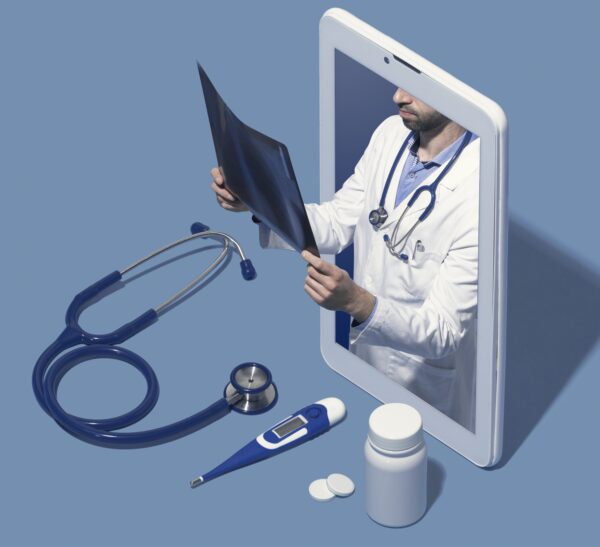 I won’t delve into Covid-19’s impact on our country and healthcare system, but the one silver lining has been the market response to drive a better consumer healthcare experience. Virtual Care is having its moment in the sun. In fact, McKinsey estimates that $250 billion of US healthcare spending could potentially be shifted to virtual or virtually-enabled care.
I won’t delve into Covid-19’s impact on our country and healthcare system, but the one silver lining has been the market response to drive a better consumer healthcare experience. Virtual Care is having its moment in the sun. In fact, McKinsey estimates that $250 billion of US healthcare spending could potentially be shifted to virtual or virtually-enabled care.
And the timing couldn’t be more suitable, considering some of the significant issues we’re facing in the healthcare industry. Physician burnout rates are at an all-time high after the latest Omicron wave. It’s reported that 3.6 million individuals forego medical care yearly due to transportation issues, including lack of vehicle access. And about half of U.S. adults say they have difficulty affording health care costs.

With the Rise of AI, What IP Disputes in Healthcare Are Likely to Emerge?
Munck Wilson Mandala Partner Greg Howison shared his perspective on some of the legal ramifications around AI, IP, connected devices and the data they generate, in response to emailed questions.
We did an exercise with a team in our company to understand how employees preferred to seek healthcare. A vast majority of our employees (I should note: mostly millennials) cited virtual care appointments as one of their first steps in seeking care for health issues. Now, a new CVS Health survey shows that patients of all ages actually find telehealth to be beneficial.
Many patient surveys show similar sentiments. A 2022 JD Power survey shows strong consumer response to virtual healthcare: 67% of their survey respondents accessed video telehealth services during the past year, and a whopping 94% of patients and their families who received medical services through a telehealth provider in the past 12 months said they “definitely will” or “probably will” use telehealth to receive medical services in the future.
These are encouraging numbers, but two things need to happen to create a more equitable healthcare system.
- We need to ensure the right populations access virtual care technology…
The U.S. Department of Health and Human Services (HHS) reported that telehealth usage was among young adults ages 18 to 24 (72.5%), those earning at least $100,000 (68.8%), those with private insurance (65.9%), and White individuals (61.9%). In short: we need to do better to remove barriers to virtual care.
Telehealth and other virtual care technologies can help bridge socioeconomic disparities in health access. We know that young adults are utilizing this care method – there is potential for using this population to assist older patients in seeking the care they need conveniently. There’s also an opportunity for payers or providers to pre-identify areas with strong broadband connections before a visit. It is encouraging to see the push for more access from the federal and state levels.
Flexible scheduling is also a tremendous opportunity for those who may not be able to access healthcare during standard work hours, as well as for providers who are looking to establish more of a work-life balance by taking appointments at varied off-times like weekends or after hours.
- …at an affordable price point in areas that need it most.
Financial means should not dictate the quality of care you receive. Healthcare costs are rising, disproportionately affecting uninsured adults, Black and Hispanic adults, and those with lower incomes. Healthcare pricing is complex, but transparent billing and pricing should enable consumers to maintain a watchful eye on spending while motivating payers to lower expenditures. As more studies prove the efficacy of telemedicine, like the one Epic conducted in 2022, I am hopeful that discussions around reimbursement will head in a positive direction.
I mentioned earlier that millions of Americans miss healthcare due to transportation-related problems so virtual care can address those living in rural areas with less access to providers.
At-home options provide private, discreet care for those in more rural areas, particularly as it relates to sexually transmitted infections. For instance, Our data shows that 29% of individuals who purchased an STI test were in health professional shortage areas, and 89% were from medically underserved areas. These stats are heartening to me as a healthcare provider – they show the tremendous growth and consumer buy-in of at-home options for care.
Where does this leave us?
The proof is here: a survey done by the American Medical Association (AMA) reported that 80% of physicians they surveyed believed that telehealth provided patients better access to care since using telehealth.
The Covid-19 pandemic was (and continues to be) a global struggle. Still, the emergence of innovations in healthcare, including telehealth and virtual Care, represents a win; now, let’s leverage virtual care to drive tangible, improved health outcomes regardless of income or location.
Source: cyano66, Getty Images
Dr. Liz Kwo, MD, MBA, MPH, is the Chief Medical Officer at Everly Health. Before joining the company, Dr. Kwo served as Deputy Chief Clinical Officer for Anthem, VP and GM of Provider Networks at American Well, and Entrepreneur in Residence at Harvard Medical School's Office of Technology Development. Board Certified in Preventive Care and Occupational Medicine, Dr. Kwo remains active as a practicing physician at Cambridge Health Alliance, of Harvard Medical School. She holds a BA from Stanford, an MPH from the Harvard T.H. Chan School of Public Health, an MBA from Harvard Business School, and an MD from Harvard Medical School. Dr. Kwo also has founded multiple venture-backed companies including the educational platform New Pathway and digital healthcare company InfiniteMD.














